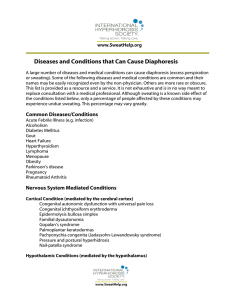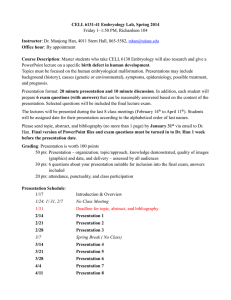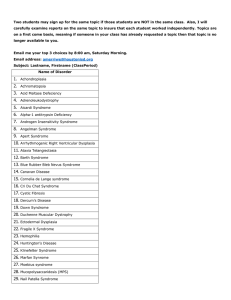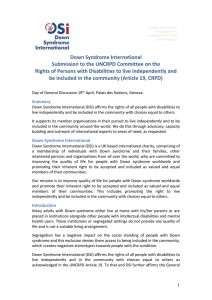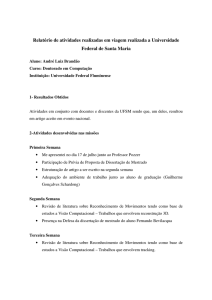ORAL PRESENTATION
advertisement
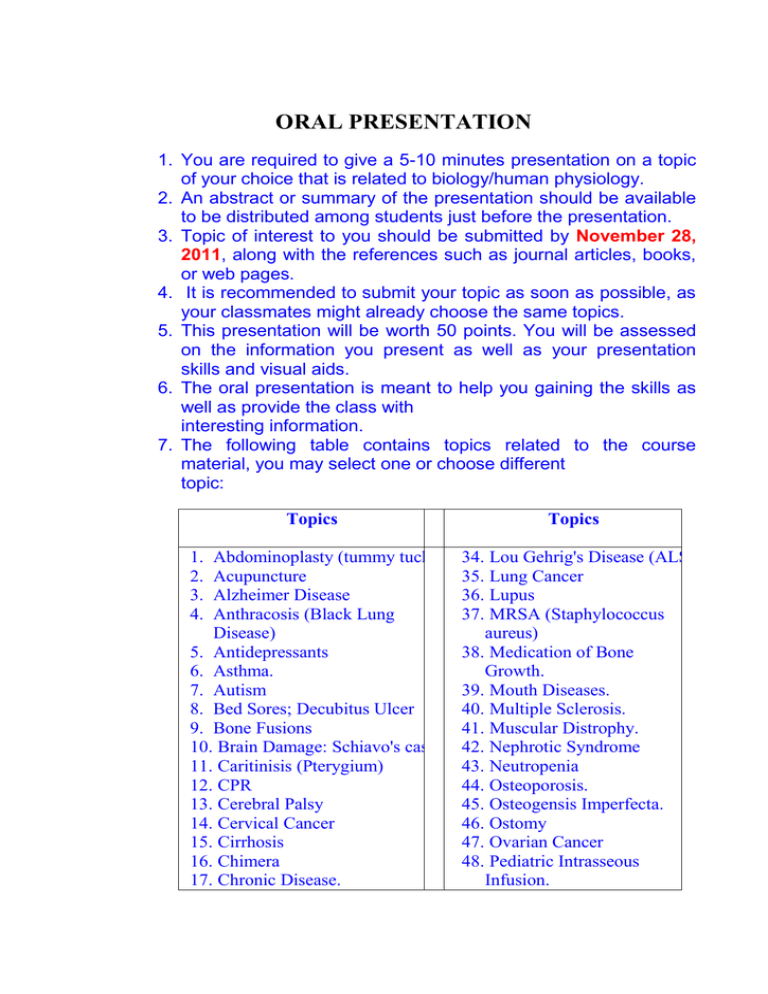
ORAL PRESENTATION 1. You are required to give a 5-10 minutes presentation on a topic of your choice that is related to biology/human physiology. 2. An abstract or summary of the presentation should be available to be distributed among students just before the presentation. 3. Topic of interest to you should be submitted by November 28, 2011, along with the references such as journal articles, books, or web pages. 4. It is recommended to submit your topic as soon as possible, as your classmates might already choose the same topics. 5. This presentation will be worth 50 points. You will be assessed on the information you present as well as your presentation skills and visual aids. 6. The oral presentation is meant to help you gaining the skills as well as provide the class with interesting information. 7. The following table contains topics related to the course material, you may select one or choose different topic: Topics Topics Abdominoplasty (tummy tuck) Acupuncture Alzheimer Disease Anthracosis (Black Lung Disease) 5. Antidepressants 6. Asthma. 7. Autism 8. Bed Sores; Decubitus Ulcer 9. Bone Fusions 10. Brain Damage: Schiavo's case 11. Caritinisis (Pterygium) 12. CPR 13. Cerebral Palsy 14. Cervical Cancer 15. Cirrhosis 16. Chimera 17. Chronic Disease. 34. Lou Gehrig's Disease (ALS) 35. Lung Cancer 36. Lupus 37. MRSA (Staphylococcus aureus) 38. Medication of Bone Growth. 39. Mouth Diseases. 40. Multiple Sclerosis. 41. Muscular Distrophy. 42. Nephrotic Syndrome 43. Neutropenia 44. Osteoporosis. 45. Osteogensis Imperfecta. 46. Ostomy 47. Ovarian Cancer 48. Pediatric Intrasseous Infusion. 1. 2. 3. 4. 18. Diabetics. 19. Diseases of the Nervous System 20. Does Your Brain Sleep? 21. Eating Disorders 22. Epilepsy. 23. Fetus-in-fetu 24. Face Transplantation. 25. Gangrene 26. Hip Replacement. 27. HIV. 28. Human Micro biota. 29. Irritable Bowel Syndrome 30. Kidney Diseases/Kidney Stones 31. Leech Therapy. 32. Leukemia. 33. Lipoprotein A 49. Pheromones. 50. Potassium as a Mineral. 51. Pre-Edampsia. 52. Renal Failure & Dialysis 53. Rheumatism. 54. Sclera derma. 55. Scapula and Clavicle Healing. 56. Scoliosis. 57. Shingles. 58. Sickle Cell Anemia 59. Skin Care and Pressure Ulcers. 60. Stroke. 61. Spinal Bifida. 62. Spinal Column Disc Injury 63. Stem Cell Technology 64. Steroids: Affects on the Body. 65. Strabismus 66. Toxic Food Syndrome ORAL PRESENTATION EVALUATION 1. Content: a. Clear, comprehensive, and accurate content follows the written paper b. Topic is relevant to the course content. c. Key points are noted. d. Topic is researched sufficiently. 2. Structure: a. Presentation is well-organized and effectively structured. b. Introduction to gain the audience's attention and explain the purpose. c. Body to explain the points of the topic. d. Conclusion to summarize the key points. e. References. 3. Style/Appearance: a. Dress and grooming are appropriate. b. Non-verbal cues/gestures are suitable to presentation. c. Time was used well/not rushed. 4. Visual Aids: a. Used where suitable. b. Easy to see and read. c. Contribute to the overall use of the presentation. 5. Audience Participation a. Engage the listeners and request feedback. b. Address the questions of the listeners effectively.




